In December of 2016, I helped folks out at a quadcopter build event at TheLab.ms makerspace. They were building 450mm quads to fly by line of sight. My friends tried to talk me into building one, too, but it didn’t look all that appealing. Everyone talked about putting cameras and gimbals on these quads, much like a DJI Phantom, and that didn’t interest me. I enjoy photography, but videography is hard work, and I rarely see compelling footage from a DJI drone.
My friend Brian really wanted me to participate in the hobby, so he bought me the most expensive piece of required equipment for Christmas—a Spektrum DX6 radio. Don’t repeat our mistake. Don’t buy a Spektrum radio. Save money, get better range, and get more features with a Taranis QX 7 or X9D+.
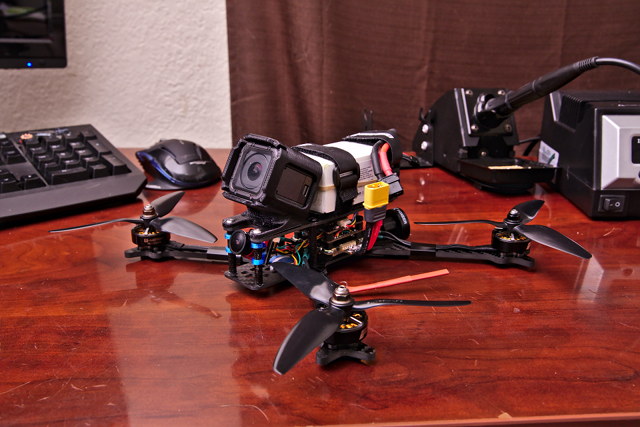
I ordered a toy quadcopter—a Blade Nano QX, and a mess of batteries, and I started playing. I started designing a 3D-printed FPV quadcopter frame almost immediately. In fact, I had it built, tested, and uploaded to Thingiverse by February 17. I had taken one of my first FPV flights a week later, and I haven’t stopped since!
Why FPV Quadcopters?
When I was in my early twenties, my friends and I enjoyed fast cars. We enjoyed driving them, and we enjoyed modifying them in an attempt to make them go faster. Most of my friends ended up zeroing in on the DSM family of cars—the Eagle Talon, Mitsubishi Eclipse, and Chrysler Laser. These were little all-wheel-drive monsters with solid, turbocharged engines that could handle a lot more boost pressure than was available from the factory.
This was at a time when V8 pony cars were running 14.5 second quarter miles from the factory. The Eagle Talon would only manage a little over 15 seconds from the factory, but it was possible to get that down into the high 12-second range with just bolt-on parts: a 2.5” or 3” turbo-back exhaust, a boost controller, and some modifications to the intake. This was a fantastic value at the time, and the car was a ton of fun to drive.
Racing quads scratch a lot of the same itches. They’re stupid quick, and easily pull 9 g or more when you punch the throttle. A fast sports car can only pull a little over 1 g. Flying an FPV quad is like playing a video game, except the quad isn’t virtual. You’re also infinitely less likely to kill someone when pushing your quadcopter to its limits, and that means you can push it to its limits all the time—no more waiting for traffic to clear up!
I suppose we don’t tend to modify quads, though, since we build them from scratch. We do often upgrade parts as things wear down or break, though, so that’s a little like modifying a car. I’ve spent more money on bigger turbochargers than I’ve ever spent on a single quadcopter.
And speaking of video games, building quadcopters is a lot like building a computer. There’s a wide array of components available at various price points, and you get to pick and choose what will meet your needs and fit into your budget. Unlike building a gaming rig, our quads need to be sturdy enough to survive crashes at over 80 MPH, and the build process involves quite a bit of soldering.
Racing quads? Are you racing these things?
Sometime early last year, I ran into some drone-racing guys at my favorite park. They were packing up their race gates as I was arriving, but we chatted for a few minutes. They wanted to know if I raced, and I told them that I didn’t. So they said that I must be flying freestyle, and I didn’t really think that was true, either. I was still learning.
I was every bit as much of a freestyle pilot as I was a racing pilot at that point. I was just trying not to hit trees, trying to fly a little faster each day, and trying to get a little closer to hitting things without actually making contact.
Racing sure didn’t sound like my cup of tea. I’ve participated in racing events before, but that was with cars. We used to go to the drag strip a lot—all-wheel drive is fantastic off the line! I didn’t race often, though. Running at the drag strip meant 10 to 20 seconds of driving followed by a whole bunch of waiting.
Drone racing is similar. You fly for two minutes, give it everything you’ve got, and then wait for another turn to go. This isn’t for me.
When I go out flying with my friends, it is normal for me to fly enough batteries to stay in the air for 60 to 90 minutes.
What is freestyle?
I often meet passersby while flying, and they usual inquire about the drone in my hands. I always tell them the same thing. These are FPV racing quads, but I don’t race. I fly freestyle. It is all about having fun and doing various tricks. It is a lot like skateboarding, but also a little like barnstorming!
When flying freestyle, I’m trying to have fun. I’m trying to pull off interesting maneuvers, and those maneuvers get more difficult and technical as my skills progress. I’m also capturing this with a GoPro in the hopes that I collect enough interesting footage on a single outing to string together a fun two- to three-minute video that I can set to music.
I went out exploring today. I started with a spot I've hit before, though. It is unfortunate that it was so cloudy and dreary today. pic.twitter.com/LKXJuUzgqZ
— Pat Regan (@patsheadcom) December 29, 2018
I spend most of my time flying in parks, though, so the video has been getting repetitive. Office buildings make for some awesome video, but they’re busy at least five days a week, so I don’t get much practice at locations like that.
We build and repair just as much as we fly!
This is definitely an exaggeration, but for a while it was surprisingly close to the truth. My friends and I used to buy cheaper gear, and quadcopter components weren’t nearly as bulletproof two years ago as they are today.
In those days, something was always breaking. Some days we’d smash a camera, other days we’d burn out an ESC. Sometimes you bend a motor or break an arm. Every now and then, the problem is less obvious.
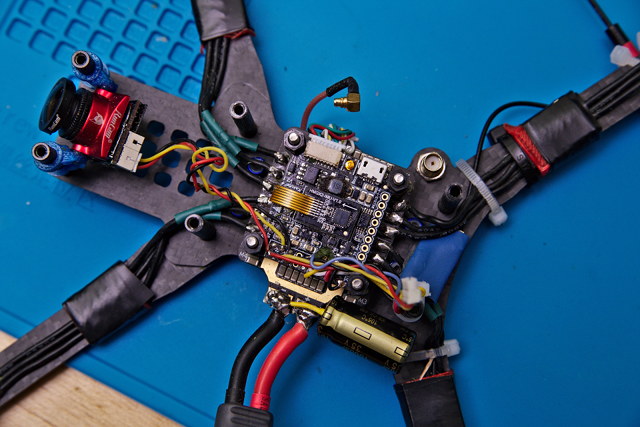
A combination of things have happened to help alleviate this problem for me. I don’t crash as often now. When I do, it is often much more spectacular, though. I’m buying higher-quality parts. The quads I fly today cost about $550 each, and I have to invest several hours building each one myself. Two years ago, I was flying a preassembled quad that cost less than $250.
It also helps that I’m spending most of my time flying at parks. I’m slowly finding new spots to fly, and those spots are full of concrete and steel. I imagine that pendulum is going to swing back the other way for me soon!
If you enjoy tinkering, soldering, repairing, and upgrading, then this hobby might be a good fit for you. I know some folks that enjoy building even more than they enjoy flying!
- Updating My 2018 FPV Freestyle Quadcopters for 2019
- The BFight 210 is Awesome and the Demise of My Shuriken X1
You don’t need to be a pro to enjoy flying FPV!
I always have a good time when I can get better at something. Especially when I can see that progress. I had fun when I was golfing. I got to watch my drives go farther and straighter. I also enjoyed practicing pitching the ball onto the green from 50 yards out. I always hated putting. I still hate putting.
I play quite a few video games with high skill ceilings, and I’m always excited when I start regularly pulling off difficult moves.
The same is true when flying FPV. I had fun when I was lucky to take off, fly a few laps around a big open field, figure out where I was standing, and disarm the quad six feet above the ground—sometimes referred to as landing. I had fun when I was learning to fly under trees. I was ecstatic the first time I pulled off an S-turn and a power loop!
I’m still learning, and I’m still experiencing that feeling. I have more free time to fly, so I’m progressing faster than most of my friends. No matter how quickly they’re progressing, though, they’re still having fun. They’re enjoying every step of their journeys.
I get out to fly four or five times a week, even if I’m only out long enough to fly one or two batteries. My friend Brian usually only gets out on weekends—winter daylight hours aren’t helping him! We have other friends that get out to a park once or twice a month.
These 5” racing quads look mean and scary!
They are. At least, they can be. Safety first!
These propellers spin at over 20,000 RPM. The tip of the props can be moving at up to 300 miles per hour! If you’re negligent, they can cut you open right to the bone. Most of our quadcopters weigh more than a pound. My setup weighs 1.6 pounds when in the air, and I’ve clocked it at over 120 miles per hour using GPS.
It was a good day for crashing. Here's the first big one. I got mud on everything, I had to walk a long way, and my foot got wet, but at least I found a bunch of golf balls! pic.twitter.com/GWbn4SXFjH
— Pat Regan (@patsheadcom) January 6, 2019
You can’t just fly these things around a crowd of people. Getting started in the hobby can be intimidating.
We don’t just fly big, heavy quads!
We fly smaller quads, too. Some of them are small enough to safely fly indoors.
I have a 3” micro quad—a Leader 3 from Full Speed RC. When we refer to the size of our quadcopters, we are measuring the propellers. My Leader 3 weighs less than six ounces, but it can still reach speeds of in excess of 80 miles per hour. Both [my 5” quads][phq] and my Leader 3 can reach their top speeds in less than three seconds.
The Leader 3 may be too fast and powerful to fly indoors, but it is an order of magnitude safer than my big freestyle quads. It is a great way to build confidence flying outside before moving up to a 5” quad, and it is fun for me to fly when the 5” would be too loud or dangerous.
There are all sorts of options for indoor fliers. The venerable Tiny Whoop has been a popular indoor FPV drone for years. In fact, I used to fly a cheap Tiny Whoop clone myself—the Eachine QX65. There’s been a lot of progress recently in this category, though, and I think there are a lot of better options now.
I recently picked up an EMAX Tinyhawk. It weighs more than a Tiny Whoop, but it’s still less than two ounces. The extra weight comes from the much sturdier frame, better motors, and bigger battery. I’ve been having a great time flying my Tinyhawk. It is a big upgrade over my Eachine QX65, though I hear the official Tiny Whoop and Newbeedrone Acrobee both fly better than the Tinyhawk.
I’m excited about the Tinyhawk bundle Emax is offering. It includes everything you need to get flying for $165: a Tinyhawk, box goggles, a controller, a battery, and a 6-port charger. Throw in some extra batteries—you always need more batteries, and you’ll have everything you need to get started for less than $200.
How do you get started flying FPV quadcopters?
I could write an entire post about how to get started in the hobby. I’ll do my best to keep it brief here. There are three or four common paths to get into FPV quadcopters, but you can definitely land anywhere in between. There’s no right or wrong way to do it. Each path has advantages and disadvantages.
Jump into the deep end
Buy a $200 Taranis X9D+ and $500 Fat Shark HDO goggles with a $170 RapidFire module. Then spend $600 on parts to build an awesome 5” freestyle quad, and stick a $400 GoPro HERO7 Black on top. Then you can throw all that stuff into a $200 backpack. You’ll realize that you’ve spent over $2,000, and you haven’t bought a charger or batteries yet!
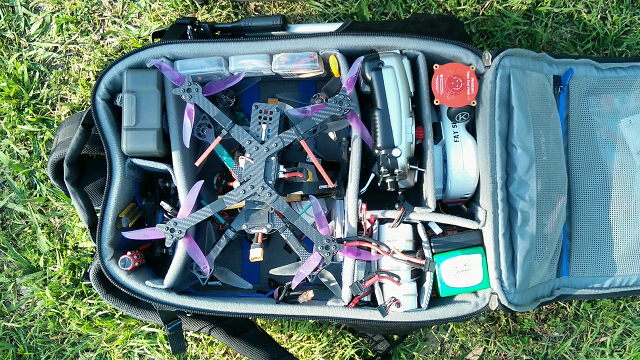
Each battery will fly 3 to 6 minutes, and they cost about $25. A charging setup will run you between $60 and $150.
Not many people begin their journey this way.
5” on a budget
You can start with 5” without spending nearly that much money. Skip the GoPro and use a backpack that you already have lying around. Buy a $120 Taranis Q X7, a $70 set of Eachine EV800D box goggles, and a $180 bind-n-fly freestyle quad like the Eachine Wizard 220HV. You’ll still need batteries and a charger.
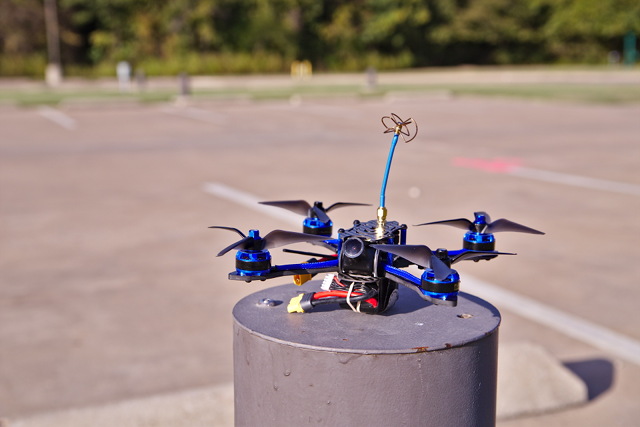
That’s less than $400. You’ll eventually want to upgrade the goggles, and the Eachine Wizard will probably need repairs quite often, but this is a much more reasonable way to get a feel for the hobby.
Each battery will fly 3 to 6 minutes, and they cost about $25. A charging setup will run you between $60 and $150.
For a long time, my friends and I were recommending the BFight 210. Even when it was new, you could get it for around $130, and some of my friends are still flying theirs over a year later. Unfortunately, the BFight 210 is getting outdated and is harder to find, so I’m recommending the Eachine Wizard X220HV—the HV model is a huge improvement over their older models.
I don’t feel great about recommending something I haven’t used myself, but that’s the best I can do right now!
2.5” or 3” is a better way to start
Buy all the same gear I mentioned in the previous section, but skip the Eachine Wizard. Buy a Full Speed Leader 3 instead. You’ll save $60, and your batteries will be even cheaper!
A little over a year ago, I might not have made this recommendation. These days, though, 2.5” and 3” quads fly an awful lot like a 5”. They’re also a fantastic way to learn to fly.
You won’t need as much space as you do with a 5” quad. They aren’t nearly as heavy, so you won’t be paying to repair someone’s windshield!
Batteries are a little cheaper. Each battery will fly for 3 to 5 minutes, and they cost about $12. You’ll use the same charging setup, and that will set you back somewhere between $60 and $150.
Forget about the real world
You don’t have to buy goggles. You don’t have to buy a quadcopter. The only piece of hardware you need to get started is the controller, also known as the radio. You can plug the $120 Taranis Q X7 or $200 Taranis X9D+ into a USB port on your computer, and use it with several popular FPV quadcopter simulators.
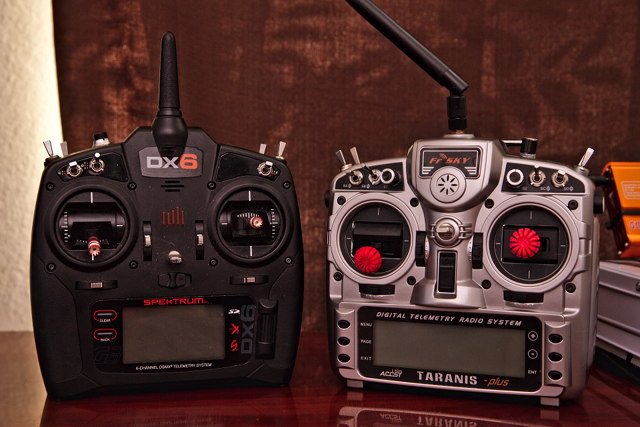
This is the direction I point everyone in. Forget about the real world. Get a radio and hop in the simulator. The monetary investment is small. You won’t break anything when you crash. Simulator or not, you will crash a lot. You won’t have to waste time searching for your quadcopter when you crash. Did I mention that you’ll crash a lot? You won’t have to charge batteries, either.
NOTE: Yell at me about this old video. It is well over a year old, but it is the only Liftoff video on my YouTube channel. I need to record something better!
Every time you crash, you just hit the reset button and start over.
The simulators won’t turn you into a pro. I always tell people that I fly seven times better in the simulator than I do in the real world, and it isn’t as much of an exaggeration as you might think. The flight controllers and software on our quads have been improving at a tremendous pace, so the gap between the simulator and real life is closing, but you still won’t be able to pull off everything you manage in the simulator in real life. You eventually need to practice on the real thing!
There are free simulators, like FPV Freerider, but I always recommend Liftoff. It is available on Steam for $20 and supports Linux, Mac, and Windows. Liftoff is more capable than FPV Freerider, has more interesting maps, and you can directly transfer your rate settings between Liftoff and a real racing quad running Betaflight.
- Liftoff FPV Simulator on Steam
But the simulator just isn’t enough for me!
This brings us back to where we started. There are plenty of indoor-friendly drones to choose from. The don’t fly much like a 3” or 5” quad, but they’re a ton of fun, and they’ll get you used to the controls. They’ll also help safely scratch the FPV itch if you’re not patient enough for the simulator.
As I said earlier, Emax has a fantastic bundle with everything you need to get flying for $165. Throw in another five batteries for $25 more, and you’ll be having a blast.
If you buy a Taranis radio to learn with the simulator, the Emax Tinyhawk would be a good second step on your journey. The base Tinyhawk is $99 without the radio and goggles. It will bind right up to your Taranis, and it comes with a battery and charger. You’ve been flying in Liftoff already, so I don’t have to tell you that you’ll want more than one battery.
The Tinyhawk will fly outside, as long as it isn’t too windy. Around the house, I get nearly four minutes of flight out of each battery. There’s more room to maintain speed outside, so it is easy to drain a battery in two minutes!
- Emax Tinyhawk Ready-to-Fly bundle at Pyro Drone
- Emax Tinyhawk at Pyro Drone
- 6 Batteries for the Emax Tinyhawk at Pyro Drone
Conclusion
It doesn’t matter if you’re flying around open fields doing flips and rolls, or you’re pulling off a sweet dive down the Empire State Building. It doesn’t matter if you have inexpensive gear, or you’re carrying thousands of dollars’ worth of hardware around in your backpack.
Flying FPV is fun. It is fun when you’re just starting out. Learning new tricks can be challenging but rewarding. Everyone I fly with is having a good time regardless of their skill level.
For some of us, it is a lot like driving fast sports cars, but with a lot of advantages. Flying FPV quads is so much cheaper, our quads accelerate faster than a Top Fuel drag car, and they corner harder than a Formula One race car. It is like playing a video game in real life.
Do you fly FPV quads? Are you racing or doing freestyle? Did I miss anything important here? Tell me about it in the comments or stop by to chat on our Discord server!
- Updating My 2018 FPV Freestyle Quadcopters for 2019
- The BFight 210 is Awesome and the Demise of My Shuriken X1
- Full Speed Leader 3 Micro FPV Racing Drone
- Emax Tinyhawk Ready-to-Fly bundle at Pyro Drone
- Emax Tinyhawk at Pyro Drone
- 6 Batteries for the Emax Tinyhawk at Pyro Drone
- Tips For First Time FPV Quadcopter Pilots